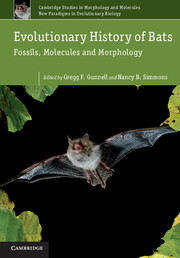Book contents
- Frontmatter
- Contents
- Contributors
- Preface
- 1 Phylogenies, fossils and functional genes: the evolution of echolocation in bats
- 2 Systematics and paleobiogeography of early bats
- 3 Shoulder joint and inner ear of Tachypteron franzeni, an emballonurid bat from the Middle Eocene of Messel
- 4 Evolutionary history of the Neotropical Chiroptera: the fossil record
- 5 New basal noctilionoid bats (Mammalia: Chiroptera) from the Oligocene of subtropical North America
- 6 Necromantis Weithofer, 1887, large carnivorous Middle and Late Eocene bats from the French Quercy Phosphorites: new data and unresolved relationships
- 7 African Vespertilionoidea (Chiroptera) and the antiquity of Myotinae
- 8 Evolutionary and ecological correlates of population genetic structure in bats
- 9 A bird? A plane? No, it's a bat: an introduction to the biomechanics of bat flight
- 10 Toward an integrative theory on the origin of bat flight
- 11 Molecular time scale of diversification of feeding strategy and morphology in New World Leaf-Nosed Bats (Phyllostomidae): a phylogenetic perspective
- 12 Why tribosphenic? On variation and constraint in developmental dynamics of chiropteran molars*
- 13 Necromantodonty, the primitive condition of lower molars among bats
- 14 Echolocation, evo-devo and the evolution of bat crania
- 15 Vertebral fusion in bats: phylogenetic patterns and functional relationships
- 16 Early evolution of body size in bats
- Index
- Plate section
- References
3 - Shoulder joint and inner ear of Tachypteron franzeni, an emballonurid bat from the Middle Eocene of Messel
Published online by Cambridge University Press: 05 June 2012
- Frontmatter
- Contents
- Contributors
- Preface
- 1 Phylogenies, fossils and functional genes: the evolution of echolocation in bats
- 2 Systematics and paleobiogeography of early bats
- 3 Shoulder joint and inner ear of Tachypteron franzeni, an emballonurid bat from the Middle Eocene of Messel
- 4 Evolutionary history of the Neotropical Chiroptera: the fossil record
- 5 New basal noctilionoid bats (Mammalia: Chiroptera) from the Oligocene of subtropical North America
- 6 Necromantis Weithofer, 1887, large carnivorous Middle and Late Eocene bats from the French Quercy Phosphorites: new data and unresolved relationships
- 7 African Vespertilionoidea (Chiroptera) and the antiquity of Myotinae
- 8 Evolutionary and ecological correlates of population genetic structure in bats
- 9 A bird? A plane? No, it's a bat: an introduction to the biomechanics of bat flight
- 10 Toward an integrative theory on the origin of bat flight
- 11 Molecular time scale of diversification of feeding strategy and morphology in New World Leaf-Nosed Bats (Phyllostomidae): a phylogenetic perspective
- 12 Why tribosphenic? On variation and constraint in developmental dynamics of chiropteran molars*
- 13 Necromantodonty, the primitive condition of lower molars among bats
- 14 Echolocation, evo-devo and the evolution of bat crania
- 15 Vertebral fusion in bats: phylogenetic patterns and functional relationships
- 16 Early evolution of body size in bats
- Index
- Plate section
- References
Summary
Introduction
Over 600 Middle Eocene bat specimens have been excavated from the Messel pit (Grube Messel, near Darmstadt, Germany), and seven species have been described thus far. Many of the fossils are preserved as complete skeletons, often with soft body outlines and gut contents. Six of the bat species represent three extinct families, whereas Tachypteron franzeni can be assigned to the extant family Emballonuridae (Storch et al., 2002). T. franzeni is known only from two specimens; however, these are extraordinarily well preserved, including the shoulder joints and inner ears, so this had already been recognized in the original description of T. franzeni, and these close resemblances to extant emballonurids led to the conclusion that T. franzeni had already evolved similar bioacoustic specializations and a similar flight style to modern taxa.
The shoulder joints of bats are sophisticated structures showing remarkable morphological variation. Miller's (1907) investigations on the differentiations of the shoulder within the Microchiroptera were continued by the studies of other authors (Vaughan, 1970; Strickler, 1978; Hermanson and Altenbach, 1983).
Three different types of shoulder joint can be distinguished within the Chiroptera: the primitive morphology of the shoulder joint with a globular humeral head and corresponding glenoid cavity, as seen in Megachiroptera and Rhinopomatidae; a derived shoulder joint with an oblong humeral head and a single trough-like articular surface on the scapula, found in members of the superfamilies Emballonuroidea, Rhinolophoidea and Noctilionoidea; a derived shoulder joint with a secondary articulation between the tuberculum majus and a secondary articular facet on the dorsal side of the scapula, as seen in the remaining families. Their distribution within the order gives evidence of parallel evolution of the derived types (Schlosser-Sturm and Schliemann, 1995). The morphological modifications of the derived joints are interpreted as a functional response to a biomechanical demand connected with flight (Norberg, 2002), i.e., to limit pronation of the humerus during the downstroke of the wing beat cycle, realized in two different mechanical ways (Schlosser-Sturm, 1982; Altenbach, 1987; Schliemann and Schlosser-Sturm, 1999). Because movement restriction was described for the primitive type as well (Bergemann, 2003), functional interpretations are still a matter of controversy.
- Type
- Chapter
- Information
- Evolutionary History of BatsFossils, Molecules and Morphology, pp. 67 - 104Publisher: Cambridge University PressPrint publication year: 2012
References
- 2
- Cited by



